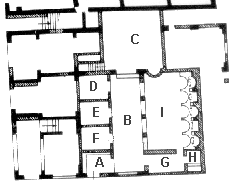|
The House of Cupid and Psyche was excavated in 1938. It was installed in late antiquity in rooms behind shops dated to the second century AD (opus mixtum and latericium). Some shops to the west of the house remained in use. They are behind a porticus, that lost its function after the erection of walls with which the shops were expanded. The main entrance is in the south: vestibule A. There are benches along the north and west wall, originally covered with marble. On the floor is a coarse polychrome mosaic without a pattern. The vestibule leads to the central room B, with a bench in the south wall and a geometric polychrome mosaic on the floor. To the north is the main room C, reached along a single marble tread, and probably two storeys high. In the south-east corner of the room is a fountain-niche with a hole in the back for a lead pipe and a marble basin. In the south-west corner is a staircase. The floor is decorated with opus sectile of the highest quality. The lower part of the walls was covered with marble, the upper part with plaster. To the south-east of the central room is corridor G leading to latrine H. To the west of the central room are three small rooms, probably bedrooms (cubicula): D, E and F. In D is a black-and-white mosaic with geometric motifs, in E opus sectile on the floor and marble revetment on the walls, and in F another black-and-white mosaic with geometric motifs while the walls were painted. A statue of Cupid and Psyche on a pedestal stood in the centre of room E. A plaster cast has been placed in the room, the original can be seen in the museum. The statue was made at the time that the house was built. Along the east side of room B was a tiny garden (viridarium I), separated from the central room by marble and granite columns, supporting arches made of brick and travertine. There was no roof over the garden. Behind the garden a monumental nymphaeum was built, with marble revetment and polychrome mosaics. The lower part consists of five semicircular niches. The upper part has five semicircular and rectangular niches, between which are marble columns. Between the bases of the columns are small marble steps, over which the water flowed. Water also emerged from holes in the front of the lower part, between the niches. The garden was the main source of light in the building.
The house was built in opus vittatum in the second quarter of the fourth century AD. It is at a higher level than that of the second century. Around the building the level was raised considerably, by dumping earth. It has been suggested that the house was in an area that was regularly flooded, and that therefore a dyke of earth was built. It is surprising that the house is not situated in the south part of Ostia, like so many other domus. Perhaps the owner was a priest of Hercules, who had a temple directly to the south of the house, which was maintained in late antiquity. |
 Plan of the house. After SO I. |








